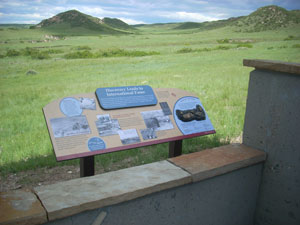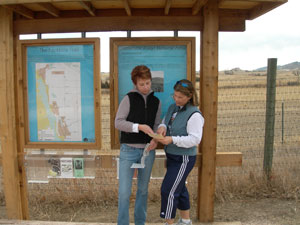
Hiking at Bobcat Ridge Natural Area.
Photo courtesy of Fort Collins Natural Areas Program

Lindenmeier Overlook at Soapstone Prairie Natural Area.
Photo courtesy of Fort Collins Natural Areas Program

Checking regulations and trail maps at Reservoir
Ridge Natural Area. Photo courtesy of Fort Collins
Natural Areas Program
Fort Collins and the northern Colorado area has a long tradition of taking care of the natural and cultural resources that make this region such a special place. From the creation of the City's first mountain park at Gateway in 1903 to the opening of expansive new natural areas and open spaces such as Soapstone Prairie and Red Mountain in 2009, we value, treasure, and protect our natural places. Many of these natural places have been protected thanks to generous citizen-supported sales taxes.
You can play an important part in making sure these resources are conserved for future generations. Always practice "Leave No Trace" ethics to minimize your impact on the places you visit. If you pack it in, pack it out. Leave rocks, plants and other natural objects as you find them. Stay on the trail at all times. Cultural resources (stone artifacts, stone circles, fire hearths, or built structures) are also commonly encountered in this area that has been inhabited for over 12,000 years. You can help preserve our collective cultural legacy by following these steps:
Leave an artifact or cultural resource where it is. Don't pick it up or walk through it. If damaged, looted, or vandalized, we lose forever the opportunity to learn from it. Instead, leave it as you found it. If you can, take a picture of it.
Record an artifact or cultural resource's location. Estimate the object's location relative to nearby landmarks. Use your camera or GPS unit to help note the artifact's location.
Tell a reliable source. If you've found an artifact or cultural resource in a City of Fort Collins natural area or Larimer County open space, contact a ranger or staff person on site, or if no one is available on site, contact the Fort Collins Museum of Discovery. An investigation of the artifact under the auspices of a valid permit will ensue.
In spite of the fact that "arrowhead hunting" was once a popular hobby, it is no longer either legal or ethically permissible. Remember that picking up artifacts or disturbing cultural resources is:
Disrespectful: these resources are part of the cultural legacy of people who have lived here, and leaving them alone demonstrates respect for the people who made or owned them. It also allows others to enjoy them today and in the future. Many American Indian groups with ties to this area believe that objects are still connected to the people who made them, and collecting them disrupts those connections.
Illegal: according to Colorado State law, it is illegal to knowingly take an artifact, or excavate, damage, or destroy any prehistorical or historical resources on public land. A person can be fined for a misdemeanor and offenders may face a fine, jail time, or both.
A loss: once an object is removed from its surroundings, it loses its ability to educate us about the past. Additionally, objects are often fragile and when people handle them they can break, or the oils and acids on our skin can permanently damage them.
As the latest link in a chain that extends more than 12,000 years into the past, it is now our responsibility to care for these places and keep their stories alive.

